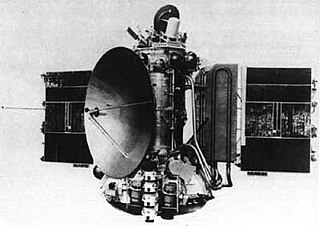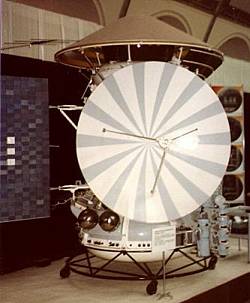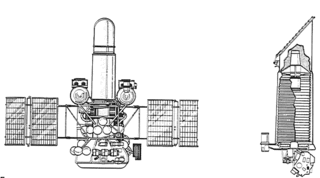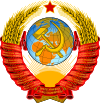Kosmos 27, also known as Zond 3MV-1 No.3 was a space mission intended as a Venus impact probe. The spacecraft was launched by a Molniya 8K78 carrier rocket from Baikonur. The Blok L stage and probe reached Earth orbit successfully, but the attitude control system failed to operate.

Mars 4, also known as 3MS No.52S was a Soviet spacecraft intended to explore Mars. A 3MS spacecraft launched as part of the Mars programme, it was intended to enter orbit around Mars in 1974. However, computer problems prevented orbital insertion from occurring.
Mars 5, also known as 3MS No.53S was a Soviet spacecraft launched to explore Mars. A 3MS spacecraft launched as part of the Mars programme, it successfully entered orbit around Mars in 1974. However, it failed a few weeks later.

Mars 6, also known as 3MP No.50P was a Soviet spacecraft launched to explore Mars. A 3MP bus spacecraft launched as part of the Mars program, it consisted of a lander, and a coast stage with instruments to study Mars as it flew past.

Mars 7, also known as 3MP No.51P was a Soviet spacecraft launched in 1973 to explore Mars. A 3MP bus spacecraft which comprised the final mission of the Mars programme, it consisted of a lander and a coast stage with instruments to study Mars as it flew past. Due to a malfunction, the lander failed to perform a maneuver necessary to enter the Martian atmosphere, missing the planet and remaining in heliocentric orbit along with the coast stage.

Venera 3 was a Venera program space probe that was built and launched by the Soviet Union to explore the surface of Venus. It was launched on 16 November 1965 at 04:19 UTC from Baikonur, Kazakhstan, USSR. The probe comprised an entry probe, designed to enter the Venus atmosphere and parachute to the surface, and a carrier/flyby spacecraft, which carried the entry probe to Venus and also served as a communications relay for the entry probe.
NPO Lavochkin is a Russian aerospace company. It is a major player in the Russian space program, being the developer and manufacturer of the Fregat upper stage, as well as interplanetary probes such as Fobos-Grunt. As of 2015, it was headed by Sergei Lemeshevskii. On August 10, 2017 the Lavochkin Association's Board of Directors appointed Vladimir Kolmykov Director General of the enterprise.

Venera 2, also known as 3MV-4 No.4 was a Soviet spacecraft intended to explore Venus. A 3MV-4 spacecraft launched as part of the Venera programme, it failed to return data after flying past Venus.

Astron was a Soviet space telescope launched on 23 March 1983 at 12:45:06 UTC, using the Proton launcher. Based on the 4MV spacecraft design and operational for six years, Astron was the largest ultraviolet space telescope of its time.

The International Astrophysical Observatory "GRANAT", was a Soviet space observatory developed in collaboration with France, Denmark and Bulgaria. It was launched on 1 December 1989 aboard a Proton rocket and placed in a highly eccentric four-day orbit, of which three were devoted to observations. It operated for almost nine years.

The 3MV planetary probe is a designation for a common design used by early Soviet unmanned probes to Mars and Venus. It was an incremental improvement of earlier 2MV probes and was used for Zond 1, Zond 2 and Zond 3 missions to Mars as well as several Venera probes. It was standard practice of the Soviet space program to use standardized components as much as possible. All probes shared the same general characteristics and differed usually in equipment necessary for specific missions. Each probe also incorporated improvements based on experience with earlier missions.

The 5VK planetary probe is a designation for a common design used for Soviet unmanned probes to comet 1P/Halley and Venus.
The Soviet Deep Space Network is a network of large antennas and communication facilities that support interplanetary spacecraft missions, and radio and radar astronomy observations for the exploration of the Solar System and the universe during Soviet times. It was built to support the space missions of the Soviet Union. Similar networks are run by the USA, China, Europe, Japan, and India.
Zond 3MV-1 No.2, also known as Venera 1964A in the West, was a Soviet spacecraft, which was launched in 1964 as part of the Zond program. Due to a problem with its carrier rocket third stage, it failed to reach low Earth orbit.
Kosmos 96, or 3MV-4 No.6, was a Soviet spacecraft intended to explore Venus. A 3MV-4 spacecraft launched as part of the Venera programme, Kosmos 96 was to have made a flyby of Venus, however, due to a launch failure, it did not depart low Earth orbit. Its re-entry into Earth's atmosphere is often speculated as the cause of the Kecksburg UFO incident.
Kosmos 167, or 4V-1 No.311, was a 1967 Soviet spacecraft intended to explore Venus. A spacecraft launched as part of the Venera programme, Kosmos 167 was intended to land on Venus but never departed low Earth orbit due to a launch failure.

The 2MV planetary probe is a designation for a common design used by early Soviet uncrewed probes to Mars and Venus.

The 1MV planetary probe is a designation for a common design used by early Soviet uncrewed probes to Mars and Venus. It was standard practice of the Soviet space program to use standardized components as much as possible.
The KTDU-425 was a former Soviet liquid fuelled engine designed Aleksei Isaev of the Isayev Design Bureau. It was mainly used on the 4MV bus, which employed it as its main propulsion system. The first version which was the KTDU-425 (11D425), which had a thrust of 18.85kN was first used in 1971 for Mars-2, Mars-3 as well as the failed M-71C probe. This was soon replaced by the KTDU-425A, which had a thrust of 18.89kN. This version was employed on the remaining 4MV and 5VK probes built, as well as Phobos 1 and 2.

The Mars-69/M-69 or 2M was the designation given to 2 Soviet Mars probes that were to be sent in 1969. Based on the Luna E-8 landers used for Luna 15-24, they were the first attempted Mars and Interplanetary Orbiters. The probes, however, were both destroyed in separate launches in early 1969.














